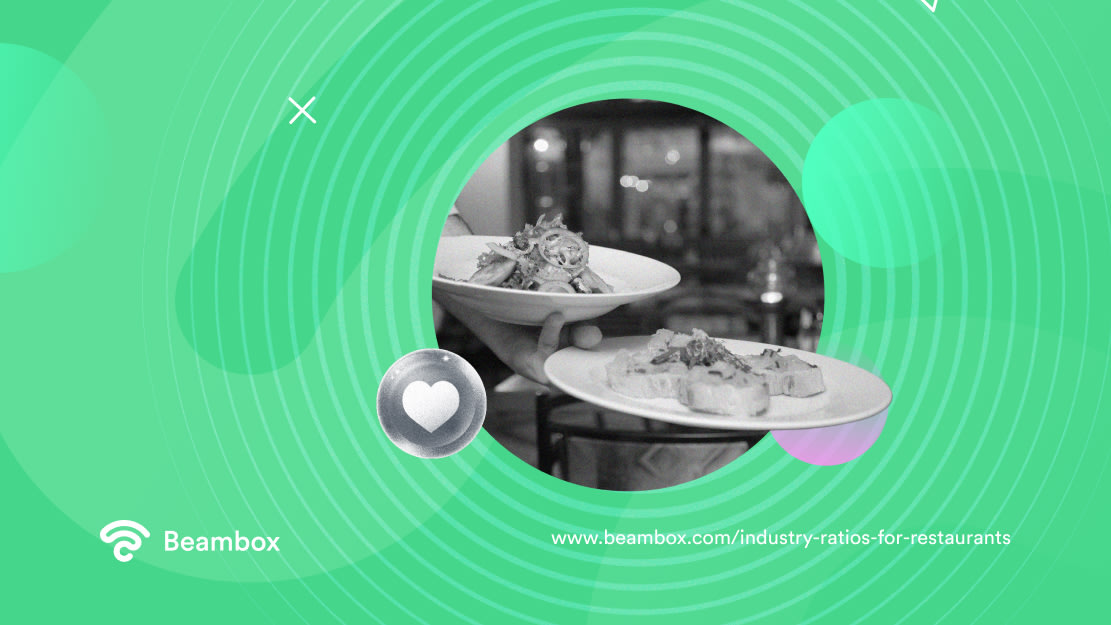Numbers might not be everyone’s favorite, but businesses can’t survive without them. The restaurant industry is no exception. You won’t be able to know how well your business is performing unless you track industry ratios for restaurants.
Of course, the purpose of starting any business is to make good profits. But measuring this single aspect won’t work in your favor.
What if there comes a point when you’re not happy with the results and you want to improve your profits?
You’ll have to go back to the first step of your business operations to see where you can improve. During that process, you’ll need a lot more information than simply knowing how much money you’re making. So, let’s cut to the chase.

Using Comparative Ratio Analysis to Improve Your Restaurant
Change and improvement are human nature. Adjusting your plans and learning from feedback is part of life and business. But how will you make improvements if you’re not even aware of the situation?
Comparative ratio analysis makes it easier for you to judge your financial position. You can use it to see the change in your performance over time. Or see where you stand among your competitors by comparing your ratios with them. Here are the five types of ratios that it revolves around.
- Liquidity ratios: While restaurants should work toward long-term goals, is that worth it if they can’t even fulfill short-term ones? Liquidity ratios judge your ability to pay your bills, debts, and other short-term obligations. Current ratios and quick ratios are other names of this type.
- Profitability ratios: Since the start of this article, we’ve been talking about profits. After all, that’s what you’re running your restaurant business for, right? Well, with these financial ratios, you can make better decisions about how much money to spend for a larger profit. Also, knowing the average restaurant profit margin can help you assess your situation quickly.
- Efficiency ratios: Your restaurant’s success depends on how efficient you are. But we’re not talking about simply completing orders on time. How much money you make will depend on how you use your assets. That’s what these ratios measure.
- Solvency ratios: These ratios are similar to liquidity ratios, except they work with long-term commitments. Lenders and investors use these ratios to see if they should invest in your restaurant or not.
- Market ratios: Knowing where you stand in the market can help you make better decisions to move higher. When these ratios are higher, you get the attention of more investors.
Key Restaurant Metrics and Ratios You Should Keep an Eye On
Running a restaurant is hard work. From servers to chefs to seating hosts to suppliers, it takes teamwork to keep the lights on.
That means you need to keep an eye on the performance of all of these stakeholders to continue moving upward.
Plus, various costs and customer metrics play a part in a restaurant’s success. With those additional factors in mind, here are the key restaurant metrics you should measure.

Industry Ratios for Restaurants Start With Prime Costs
Let’s start this list of industry ratios for restaurants with the two largest expenses. These are the cost of goods sold (CoGS) and total labor costs.
Collectively, these ratios go by the name of prime costs. They don’t factor in other things like equipment and restaurant marketing campaigns. Instead, they’re about the money you invested in creating menu items to sell.
Labor cost enters the picture because it’s your staff that serves and cooks the meal. Knowing these expenses is the first step to proper planning.
To calculate a restaurant’s prime costs, add the cost of goods sold and total labor costs.
But where do you get these two numbers from? CoGS includes the cost of raw materials for food and beverages. That means every ingredient that goes into making a meal at your restaurant. From meats and vegetables to salt, pepper, and oil, every pantry and fridge item goes into that number.
However, each time you calculate this metric, you’ll have some material left over from the last time. This will be the beginning inventory, and the fresh ingredients you have newly purchased will be the purchased inventory.
To calculate your CoGS, add the beginning inventory and purchased inventory. Then, subtract the remaining inventory at the end of the month from the previous amount.
Appropriately pricing your menu items becomes easy when you have this number in mind. The ideal ratio for this metric is less than 30%.
There’s a lot you have to factor in to calculate the second metric. Employee salaries, payroll taxes, healthcare, bonuses, overtime, vacations, and leaves all join hands to make up the total labor cost.
To view this as a percentage, divide total labor cost by total revenue and multiply this number by 100. Again, this ratio shouldn’t be more than 20 to 30% of your sales.

Calculating Inventory Turnover Ratio Keeps You Safe From Chaos
When you’re running a business in the services sector, you should track your inventory, too. But when it comes to restaurants, it all depends on raw materials. After all, how will you cook the dishes if you don’t have the ingredients?
Now, the inventory turnover ratio is the number of times you exhaust your inventory entirely over a period. Here’s how to calculate the inventory turnover ratio.
Say you’re calculating it for January. The first step is to add the inventory you had at the beginning of January to the ending inventory. This includes the items you purchased during the month as well as those you saved during December.
Next, divide this number by your CoGS. The last step is to divide that number by 2, and you’ll have your inventory turnover ratio.
Let’s create an example to understand this better. Suppose your CoGS stands at $30,000, with the beginning inventory at $9,000 and the ending inventory at $2,000.
Plugging these numbers into the formula gives 1.4, which means you exhausted your inventory once during the month. But is that good enough for your restaurant? Well, not really. An ideal inventory turnover ratio for restaurants is between 4 to 8 each month.
Less than four means you’re not getting enough sales. If that’s the case, it’s up to you to hunt for the issue and solve it. Maybe your menu doesn’t align with the tastes of your target audience. Or it might be your staff’s attitude that people don’t like.
On the other hand, getting a number higher than eight isn’t good either. It might mean that you’re wasting your resources. Plus, if you run out of ingredients too fast, you might not be able to keep up with customer demand.

A lot rides on how your staff treats guests, how fast they serve them, and their overall performance. If the answers to these questions aren’t good, you need to rethink your hiring.
As mentioned earlier, tracking your employees’ performance allows you to make the necessary improvements. But how?
Well, restaurant PPA is one way to go about this. It stands for the per-person average and reveals the average amount each guest spends during a visit. Of course, you can’t force customers to buy more than they’ve planned.
But you and your servers can increase your daily revenue with some clever tactics. That says a lot about your employees and the restaurant’s performance. Now, there are two ways to calculate it.
The first helps you judge how well a particular employee is performing. Simply take the total sales of that server and divide it by the number of guests they attended. Alternatively, it tells how you’re performing on a particular day. For that, divide the day’s total sales by the total number of guests you served.
This ratio will be higher for fine dining restaurants since they’re usually more expensive and wait times are longer.
Another important metric is the employee turnover ratio, which helps you judge your hiring process.
The restaurant turnover rate tells you how often you lose an employee due to bad performance, retirement, or resignation. If this number is high, there might be problems with how things work in your restaurant. Or you’re hiring the wrong people.
To calculate this metric, divide the number of employees you lost in a month by the total number of employees. Then multiply that number by 100.

Customer Retention and Table Turnover Rate Help You Make Better Decisions
While money is a big motivation for running your restaurant wisely, you’re also doing it for your customers. After all, they’re the ones who are bringing in the revenue. So, keeping them happy should be your utmost priority.
But how can you do that if you don’t have any insights into their behavior? Customer retention is a metric that helps you do just that.
It tells you how many customers you managed to keep or retain during a certain period. If this number is high, you can focus your efforts and money on other processes. Alternatively, a lower number will give you no choice but to keep acquiring new customers. In other words, it is a good measurement of customer loyalty for your business.
Studies show that retaining a customer is five times cheaper than acquiring a new one. So, why waste all that money instead of focusing on retention?
The opposite of this is customer churn, which indicates how many customers stop visiting your restaurant.
To calculate this metric, you must look at your customer retention rate. So, subtract the number of customers at the end of the period from the customers you acquired.
Next, divide that number by the number of customers you had at the start and multiply it by 100. This percentage should be between 70 to 80%.
On the other hand, the table turnover ratio throws light on efficiency in your kitchen, operating hours, and staff. It is the number of times you have to reset a table for new guests to sit.
Simply divide the parties you serve by the number of tables you have, and you’ll get the table turnover ratio.
What Should You Do With These Industry Ratios for Restaurants?
To run your venue successfully, you should know the crucial industry ratios for restaurants.
The metrics mentioned will help you see where you stand and where you can improve. You might see an opportunity to cut costs on overhead or perhaps invest in smart, cost-effective marketing tactics. For example, digital, email, or wifi marketing.
If you want to scale your marketing results and profits, try out Beambox WiFi marketing. This platform will help you grow your online reputation on the main review sites. Moreover, you’ll be able to gather data from your customers and improve your marketing campaigns. Start your free trial now!
Get Started With Free WiFi Marketing
Beambox helps businesses like yours grow with data capture, marketing automation and reputation management.
Sign up for 30 days free